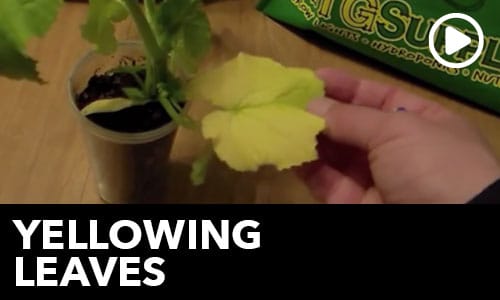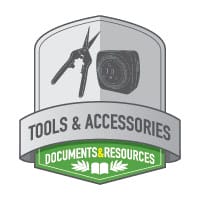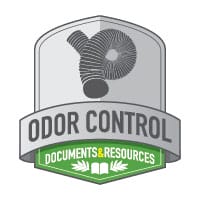Water quality is one of the most impactful variables in the indoor garden, but it is also often overlooked among growers making the transition from beginner status to next-level growing. Most of us start out using simple lights, simple nutrients, and simple methodology, which is really a good idea when you’re an indoor grower just getting your feet wet with hydroponics. But for those of us who what to refine our growing methods to push our crop further, minding water quality is an absolute must. This week in Talking Shop, we’ll discuss the differences between common water source types and the potential issues inherent in each, as well as how you can properly deal with them to make sure you get the most out of your garden. Plus, read through for our coupon code of the week on great products that will help you get the job done.
Common Indoor Garden Water Supplies
The type of water source you have usually depends on where you live. If you’re growing in a more rural area, you will probably be using water from a well. Wells usually supply one or only a few building with water pumped from an underground reservoir, or chamber that is filled naturally with ground water. If you’re gardening within the city limits, you’re most likely working with a municipal water supply that comes from a water treatment plant somewhere close by. Either of these water sources can be used for indoor gardening, but both have general characteristics that can lead to growing pains for ambitions growers if ignored.
Municipal (City/Public) Water Supplies
Most municipal water sources contain notable amounts of minerals including calcium, magnesium, iron, and others. While we’re familiar with these elements as favorable plant nutrients, their presence does have the potential to cause imbalances in precision feeding programs using premium soil or hydroponic nutrients. The larger issue with public water supplies is the presence of sanitizers like chlorine and chloramine, as well as other minerals such as fluoride. Chlorine and chloramine are both known to slow growth during the vegetative stage, while fluoride can negatively impact the flowering cycle. Buffering for pH is also part of the water treatment protocol for many municipalities, which can create pH balancing challenges.

Private Wells
Well water doesn’t normally contain any sanitizing agents, but it does present its own list of potential issues as an indoor garden water source. The mineral composition of well water usually includes the same elements listed above, however, concentration levels of these substances in untreated tap water from wells can often fall outside of the desirable range. As a natural water source, wells are also vulnerable to sulfur, arsenic, and lead contamination.
There is also the issue of water hardness, which can exist in either of the water source types discussed here, but is more common in wells. ‘Hard water’ refers to the presence of insoluble forms of calcium and magnesium – the same substances that cause annoying scale buildup on plumbing fixtures. Although water softeners can remove these. substances, they don’t really solve the problem because the softening process only replaces unwanted calcium and magnesium with sodium, which is perhaps equally as detrimental to optimal plant growth.
Effects of Water Quality on Plant Growth
Although municipal and well water makeup tends to differ significantly, water quality issues among the two often result in the same issues. That said, the exact manner in which impurities associated with either type will affect your plants depends on the growing method you use.
pH / EC
If you’ve made it past the ‘Hydroponics 101’ level, you’re probably somewhat familiar with how the pH and electrical conductivity (EC) of nutrient solution affects plant growth. If you’re still using tap water blindly though, it’s more or less impossible to know how it is affecting these parameters. For example, water from wells often contains a significant amount of dissolved solids (minerals), which usually results in a pH reading toward the alkaline end of the scale. Even when using pH adjusters to correct this high pH in reservoirs or soil feeds, alkalinity can build up in grow mediums over time, which usually lead to nutrient lockout and loss of harvest potential. City water can also present pH issues in the form of pH buffers. Buffers are sometimes added to municipal water sources to stabilize pH. While this is beneficial for a number of reasons from a human-consumption standpoint, these buffers also make the water resistant to adjusters, which is an obvious issue for grow room applications.

In the same respect, a high base mineral content indicated by the EC (AKA, TDS or PPM) can displace, or worse yet, cause nutrient toxicity levels where the amount of a given substance is too high. This would lead to what is commonly known as ‘nutrient burn’. Assuming that a high base PPM can be compensated for by cutting back on nutrient doses doesn’t usually work out well either. The issue is not really how much ‘stuff’ is in your water in the form of TDS, but rather what exactly that stuff is. Even a lower EC/TDS can become a problem if the minerals in the water are those that will lead to nutrient lockout. Check out our article on EC and TDS for Plants and Hydroponics for more about these issues!
Beneficial Microorganisms
Beneficial microbiology plays a vital role in many feeding schedules, particularly in organic soil gardening. In the same way our stomachs are full of microbes that help us digest our food, a plant’s root system is dependent on the surrounding microbes to help them break down organic matter and take in nutrients. This is where the main issue with municipal water treated with chlorine or chloramine comes into play. As these substances are added to water to kill off unwanted microbes, they will also wipe out the beneficial bacteria and fungus we use, inhibiting the processing of organic compounds for plant availability.
How to Know What’s in Your Water
Whether you’re working with a well or a municipal water supply, the first step toward deciding how you’re going to address any quality concerns is testing. A good place to start is by testing your naturally occurring pH and EC (TDS/PPM) levels. These parameters can give you a basic idea of your water quality, but remember – even a quality PPM meter can only give you an idea of the mineral quantity in your water, not what those minerals are.
Understanding your water quality can be as easy as researching the published water quality report available from your water provider if you have municipal water. This document will provide detailed measurements of your tap water and can serve as a good kicking off point to understanding what will need to be adjusted. The only way to truly know what is contained within your water is to have a sample tested at a lab though. Cost varies depending on the extent of the analysis, but it’s worth it to get the full test. After all, you’re probably drinking the same water. Services are usually available locally, and if not, there are several online providers that can conduct the testing.
Grow Room Water Treatment Methods
Once you have your analysis, you can determine the level of mitigation required to have a consistent clean source of water. If you have a municipal supply, you already know that you will need to deal with chlorine and/or chloramine, and if you have a well, you will probably have a high mineral content that will need to be addressed. While you could just decide to circumvent this by going out and buying distilled water, this can become quite expensive and impractical if you’re growing anything more than a few small plants. There are a few common treatment methods that will provide you with better water in a much more feasible way.
Evaporation
One of the methods often tried by growers with a municipal supply is evaporation technique. Evaporation is the old-school practice of letting water sit out for 24 hours before use, which will cause some chlorine to evaporate. The problem with this little trick is that it doesn’t work on Chloramine, which is becoming a more commonly used sanitizer in city water supplies for this very reason. Plus, there is usually more to it than just chlorine or chloramine, even in city water. If you tested your tap water, chances are you found other unwanted substances that you’ll want to remove like fluoride and water-softening chemicals, and evaporation will do nothing in this case.
Water Conditioning Products
There is another solution for those out there with low EC municipal water supplies, in the form of additives you can mix into tap water that will instantly neutralize chlorine and/or chloramine. “Dechlorinator+” from Microbe Life is one such product, and uses Sodium thiosulfate to remove chlorine and chloramine and is safe for both horticulture and aquaculture. Growers that are on a budget or have especially clean tap water could consider dechlorinating with additives like this, but it’s still not an optimal solution as it doesn’t remove undesirable mineral content.
Water Filter Systems
If you want to be in complete control of your water quality, a filtration systems is the only way to go. While you can get by with a base EC of up to 0.1 (100 PPM), many city water sources and certainly most wells will not fall within this range. If your unfiltered tap water reading is approaching 200 PPM, the door is open for base mineral content to become an issue, and anything over 300 ppm crosses over into the mandatory filtration side. Most tap water sources will fall within this range, but luckily, there are some effective and affordable solutions that can be easily integrated with most grow room water supplies.

Dechlorinator Systems (2-Stage Filtration)
A dechlorinator can be used in place of a full water purification system to rid your water chlorine and chloramine as well as some larger mineral content. These simple filtration systems typically use a sediment filter (stage 1) and a single carbon filter (stage 2). The sediment filter removes larger particles and impurities from the water supply, while the carbon filter(s) in the system will remove better than 99% of chlorine and chloramine. This will take care of the larger issue with city water and protect any beneficial microbial life you’re using, but it will also leave some mineral and possibly other smaller unwanted substances as well. The concern with this type of approach is that many of the feeding schedules developed by nutrient manufacturers are designed for use with 0 PPM water, and would require some adjusting to accommodate existing dissolved solids in the water supply.
Reverse Osmosis Systems (3-Stage Filtration)
Reverse osmosis systems are the most reliable means of obtaining optimal water quality. So, what exactly is reverse osmosis? While it sounds very complex, the process is actually pretty simple when you get down to it. If we understand osmosis is the natural movement of a solvent (water in our case) through a semipermeable membrane (filter) to an area of higher solute (TDS) concentration, then it makes sense that reverse osmosis relies on an outside force (water pressure) to move our solvent from a higher concentration through the filter to a lower or essentially solute-free concentration. Reverse osmosis (RO) systems accomplish this by forcing water through a series of filters including the sediment and carbon filter types listed above. As RO systems are generally used for higher-volume applications, they usually feature dual carbon filters to help extend filter life.
After water passes through the carbon and sediment filters in an RO system (commonly referred to as the prefilters) they enter the RO membrane, which is the 3rd and most important step of the filtration process. An RO membrane is a specialized filter that is comprised of many layers of perforated sheets, each sheet with smaller openings than the next. As water enters the membrane, it is directed through the layers in order toward the middle of the filter. Each layer removes smaller and smaller particles as the water moves through them, with the clean water pushed through the tube in the center. Waste water containing the particles left behind is flushed through the filter to waste. When set up and maintained properly, quality RO systems like the Pure 100 RO by AgroMax can effectively filter particles and chemical substances down to 0.0009 micron, leaving the remaining water clean and free of any impurities.
It should also be noted that to make all of this work, the correct pressure is required in the system. Systems usually achieve this through the use of a restricting valve, but the source water must also meet the minimum pressure (psi) requirements in order for the system to run properly. Municipal water supplies usually fall within the correct pressure range. Wells, however, often require the use of an auxiliary pump in order to maintain the proper pressures. In either case, be sure to check your existing water pressure ahead of time and compare with the reuirements of your system.
Pure & Clean Water = Peace of Mind
As you can see, starting with pure and clean base water will not only let you get the most out of the nutrients you’ve invested in, but it will eliminate a lot of potential headaches when trying to refine your growing operation. While it’s true that there are plenty of nutrient lines available that are “safe to use with tap water”, this can still be somewhat of a risky proposition. Reverse Osmosis (RO) systems are the best filtering option regardless of your water source. Starting with a “zero point” TDS assures you will know exactly what is being introduced into the garden system and allows you manipulate the system more effectively toward bigger and better yields.
Regardless of the purification approach you need to take, HTG Supply has both the products and the knowledge to help you get the most out of your grow. Stop by your local shop or feel free to contact us for more information, and we’ll be glad to assist!
____________
If you use any of our grow room filter systems, throw a picture on Instagram and tag us in it (@HTGSupply) – we’d love to see your results! And don’t forget to check out this week’s coupon code and sale information below! From all of us here, good luck, stay safe, and Happy Growing!



